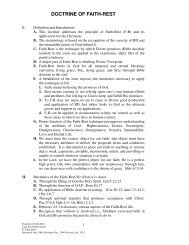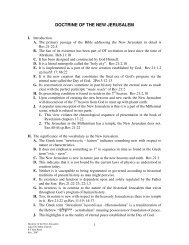Revelation 9 - Lake Erie Bible Church
Revelation 9 - Lake Erie Bible Church
Revelation 9 - Lake Erie Bible Church
You also want an ePaper? Increase the reach of your titles
YUMPU automatically turns print PDFs into web optimized ePapers that Google loves.
Chapter 9<br />
THE REVELATION TO JOHN<br />
ANALYSIS VERSES 7 – 11:<br />
1. Vss.7-11 now gives a detailed description of the demon locusts released upon<br />
mankind.<br />
2. The expanded illustration of details serves both a rhetorical and chronological<br />
purpose.<br />
3. Rhetorically it provides a second closer look at the event at hand in order to bring out<br />
some important points.<br />
4. Chronologically, it confirms that the primary period in view as it relates to the<br />
trumpet judgments is 5 months (vs.10).<br />
5. Some grammatical emphasis are seen throughout these verses to help the reader to<br />
understand its descriptive nature to include:<br />
A. The comparative nature of these descriptions as noted in:<br />
1) The opening subject noun “appearance/o ` m o i , w m a – homoioma” only used 1x<br />
in <strong>Revelation</strong> that originally meant “what is made similar/a copy”, but came to<br />
mean the form of something or the outward appearance denoting a<br />
resemblance rather than a hard copy.<br />
2) The following cognate term “like/o]moioj – homoios” used 3x denoting a<br />
likeness or similarity (vss.7 2x ,10).<br />
3) The comparative conjunction “like/as it were/w ` j – hos” used 6x further<br />
indicating similarities but not hard copies (vss.7 2x ,8 2x ,9 2x ).<br />
4) These terms combined indicate that the descriptive nature of these demons is<br />
presented in caricature rather than exact duplicates of the objects described.<br />
5) They are designed to reveal certain characteristics of manner, personality,<br />
form and function in their appearance coinciding with their method of<br />
operation.<br />
B. The consistent used of the feminine gender in the pronoun “their/a u v t o , j – autos”<br />
that always refers back to their original manifestation as “locusts/avkri,j – akros<br />
(feminine)” denoting the cohesive nature of all of these demons in likeness.<br />
6. It is to be recognized that John is describing various characteristics of these creatures<br />
by describing how they appeared physically.<br />
7. There are 9 distinct characteristics ascribed to them with the first in vs.7a, “And the<br />
appearance of the locusts was like horses prepared for battle”.<br />
8. Interestingly enough, many have noticed that the head of the locust looks like a<br />
horse’s head in miniature, which provides a built in caricature of symbolism.<br />
9. The general understanding of this phrase relates to the fact that Roman war-horses<br />
were very large, bred specifically for battle, taught to bite, and equipped with razor<br />
sharp hooves.<br />
10. Beyond that, their horses were equipped with various forms of armor for the head<br />
and body including armor of lamellar that consists of small plates laced together to<br />
form armor that could be made from hardened leather, horn, bone, layered felt, or in<br />
some cases, iron.<br />
11. John could also be referencing the fact that this group is lined up across the horizon in<br />
battle array, just as military horses would be just before the charge into battle.<br />
12. While both may be in view, the point of the symbolism here is that this army was an<br />
incredibly fearsome spectacle and would strike fear into the heart of anyone that<br />
observed it.<br />
<strong>Lake</strong> <strong>Erie</strong> <strong>Bible</strong> <strong>Church</strong><br />
P-T Ken Reed<br />
15










